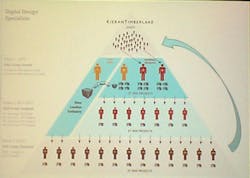BIM Forum Chicago: When does design end and construction begin?
July 20, 2011
3 min read
The mercury pushed 100 degrees Fahrenheit at the Swissotel in downtown Chicago as the BIM Forum welcomed more than 400 attendees for its summer conference asking “When does Design End and Construction Begin?” a topic that very quickly has become even hotter than the temperature outside the hotel.
“This is a conversation that’s been in our saucepan for awhile,” said John Tocci, Sr., BIM Forum chair in his opening remarks. “It wasn’t ready last year, but it’s a testament to how quickly our industry is changing that it’s ready now.”
Organizers Davis Chauviere of HKS and David Morris of EMCOR oversaw a day of robust presentations mainly from architects or other BIM specialists who work in design either for architecture firms or construction companies.
Christof Spieler, PE, a trained engineer who is director of technology and innovation at Houston architecture firm Morris Architects gave a rousing talk in one of the early sessions about both his experiences as an engineer working for architects and how further line-blurring would be needed to meet the efficiency demands of today’s clients.
“Fundamentally architects have to take responsibility for constructability, Spieler said. “Contractors must take responsibility for the design implications of construction decisions. We’ve put an awful lot of work into separating design and construction, Things that really are and should be inseparable.”
Spieler argued that the only product of either an architect, engineer or construction company is a building. Deliverables, he said, are not a product, and that what all AEC professionals are really selling is what the client gets out of that building.
Documentation is a catalyst, he said, not the product. In doing so he followed up by saying the AEC industries need to be more proactive in making the BIM model the authoritative source of project information, rather than a contractually-obligated 2D document derived from it.
Afternoon keynote speaker James J. Timberlake of Kieran/Timberlake did not delve as deeply into the question of when design ends and construction begins, but rather gave an illuminating talk on how the 65-person Philadelphia uses BIM and other software to make its technologically-advanced projects such as the Cellophane House.
“There’s a huge demand for performance, how these buildings are going to work,” Timberlake said. “This infrastructure that we’re now so heavily invested in needs to work not just at the moment we hand the client a key, but for the lifecycle of the building.”
He explained that Kieran/Timberlake does not have BIM managers or other specialists that work in technology but, rather, trains a group of “Digital Design Specialists” who then each bring their knowledge of BIM and other transformative technologies to each project they work on. The co-workers they indirectly train on those projects then spread their knowledge to co-workers they work with on other project teams specifically assigned to do just that. Kieran said the firm has gone through several cycles of digital design specialist assignments to date and when all employees have been exposed to the technology in this way, the digital design specialist program will, indeed, end as their mission will be accomplished.
The July 20 BIM Forum program includes a panel discussion of the potential BIM pitfalls featuring construction attorney Carl Robers of Ballard Spahr; Autodesk SVP for AEC Philip Bernstein, FAIA; and construction expert Jan Reinhardt of Adept Project Delivery. “BIM Among Enemies” as the panel is called will contrast “BIM Among Friends,” a presentation featuring KlingStubbins Architect Sarah Vekasy and Michael Cannistraro of J.C. Cannistraro, a full-service M/E/P contractor that has worked as a sub-contractor directly with KlingStubbins’ team on several BIM projects.
About the Author

Jeff Yoders
For five years Jeff Yoders covered IT, CAD, and BIM as Senior Associate Editor of Building Design + Construction. He's a chair at-large of the Associated General Contractors of America's BIM Forum and speaks regularly to audiences about how to transition to digital workflows. Jeff has won four American Society of Business Publications Editors awards.
Sign up for our eNewsletters
Get the latest news and updates
